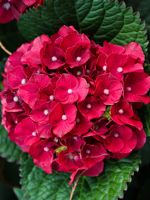Mon-Fri 9am - 5pm Mountain time
Black Elderberry vs Cherry Go Round™ Reblooming Hydrangea
Sambucus canadensis
Hydrangea macrophylla Hokomaburlac
NOT AVAILABLE THIS SEASON - MIGHT RETURN
NOT AVAILABLE THIS SEASON - MIGHT RETURN
Black Elderberry is a deciduous shrub native to eastern North America. You can plant this shrub in moist areas and it will help stabilize your soil. You can also use it on rural properties anywhere you'd use a lilac.
Black Elderberries are considered to be partially self-pollinating. So while they will still produce some berries without cross-pollination, planting with another variety will increase yields. Consider planting with Ranch Elderberry or Bob Gordon Elderberry.
Warning: the seeds, stems, leaves, roots, and uncooked berries of the Black Elderberry are poisonous to humans when eaten in quantity. You should cook the berries to make them safe for human consumption.
Cherry Go Round Reblooming Hydrangea™ is a compact flowering shrub. The deep red flowers will bloom in late spring and last until fall. The mophead-like flowers add multi season interest to your landscape. The petite form is well suited for urban yards and tight spaces.
Flowers grow on old wood which requires only spent flowers and damaged wood to be removed. The Cherry Go Round Reblooming Hydrangea is part of the Bloomin’ Easy® collection.
On the prairies, some customers will plant the Cherry Go Round Reblooming Hydrangea in pots and over winter them in their garage. They need additional winter protection for the flower buds.
Note: Flower colour may be influenced by the soil pH. In more alkaline soils the flowers will emerge more pink whereas those in acidic soils will be a deep purplish red. They prefer slightly acidic soils with a pH of 5.7-6.5.
Black Elderberry Quick Facts
Cherry Go Round™ Reblooming Hydrangea Quick Facts
Toxicity: leaves, stems, and uncooked berries are poisonous to humans

